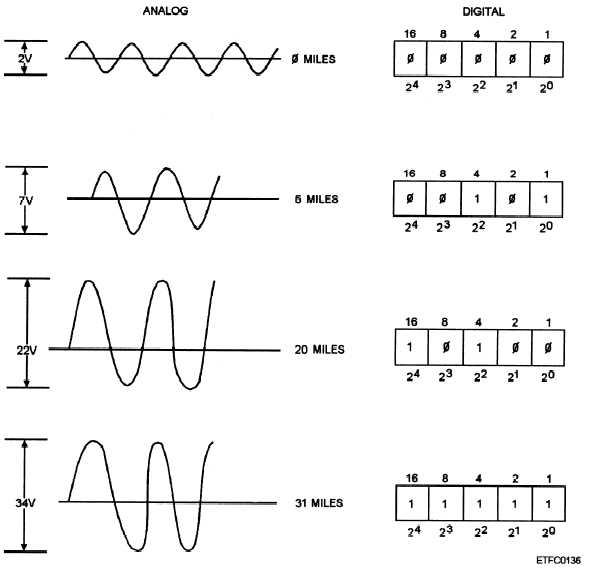the signal. Digital quantities on the other hand are
represented by binary numbers (ONES and ZEROS).
The binary ONES and ZEROS indicate the value at a
particular instant in time. Each bit position represents
a portion of the overall quantity. The summation of the
value of the set bits (ONES) is normally the quantity to
be represented. By setting or clearing particular bit
positions in the binary word, different values within a
set of limits maybe expressed.
ANALOG AND DIGITAL QUANTITY
COMPARISONS
Let’s compare an analog quantity and a digital
quantity representing the same range of values, say
from 1 to 31 miles. The analog signal will be a linear
single-phase ac sine wave. The ac signal is variable
between 2 volts and 34 volts peak to peak. An
amplitude of 2 volts peak to peak will indicate 0 miles,
the minimum limit value, and an amplitude of 34 volts
will indicate a value of 31 miles, the maximum limit.
In this example, the increasing signal amplitude
indicates an increase in range in miles.
The digital value will be expressed by five binary
bits. Each bit position when set (a binary ONE)
indicates a portion of the quantity. Bit 20 indicates a
value of 1 mile, bit 21 a value of 2 miles, bit 22 a value
of 4 miles, bit 23 a value of 8 miles, and bit 24 a value
of 16 miles. Zero miles is indicated when all bits are
clear (binary ZEROs). The maximum of 31 miles is
indicated when all bits are set (binary ONES), 31 miles
being the sum of the value of all the set bits
(1+2+4+8+16=31).
Figure 13-1 shows the analog and digital
representations of the same quantity through the range
Figure 13-1.—Analog and digital quantity comparisons.
13-2

